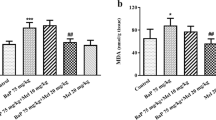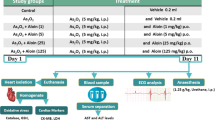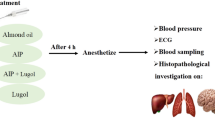Abstract
Aluminum phosphide (AlP), one of the most commonly used pesticides worldwide, has been the leading cause of self-poisoning mortalities among many Asian countries. The heart is the main organ affected in AlP poisoning. Melatonin has been previously shown to be beneficial in reversing toxic changes in the heart. The present study reveals evidence on the probable protective effects of melatonin on AlP-induced cardiotoxicity in rats. The study groups included a control (almond oil only), ethanol 5% (solvent), sole melatonin (50 mg/kg), AlP (16.7 mg/kg), and 4 AlP + melatonin groups which received 20, 30, 40 and 50 mg/kg of melatonin by intraperitoneal injections following AlP treatment. An electronic cardiovascular monitoring device was used to record the electrocardiographic (ECG) parameters. Heart tissues were studied in terms of oxidative stress biomarkers, mitochondrial complexes activities, ADP/ATP ratio and apoptosis. Abnormal ECG records as well as declined heart rate and blood pressure were found to be related to AlP administration. Based on the results, melatonin was highly effective in controlling AlP-induced changes in the study groups. Significant improvements were observed in the activities of mitochondrial complexes, oxidative stress biomarkers, the activities of caspases 3 and 9, and ADP/ATP ratio following treatment with melatonin at doses of 40 and 50 mg/kg. Our results indicate that melatonin can counteract the AlP-induced oxidative damage in the heart. This is mainly done by maintaining the normal balance of intracellular ATP as well as the prevention of oxidative damage. Further research is warranted to evaluate the possibility of using melatonin as an antidote in AlP poisoning.




Similar content being viewed by others
Explore related subjects
Discover the latest articles and news from researchers in related subjects, suggested using machine learning.References
Abdolghaffari AH, Baghaei A, Solgi R et al (2015) Molecular and biochemical evidences on the protective effects of triiodothyronine against phosphine-induced cardiac and mitochondrial toxicity. Life Sci 139:30–39
Acikel M, Buyukokuroglu ME, Aksoy H et al (2003) Protective effects of melatonin against myocardial injury induced by isoproterenol in rats. J Pineal Res 35:75–79
Anand R, Binukumar B, Gill KD (2011) Aluminum phosphide poisoning: an unsolved riddle. J Appl Toxicol 31:499–505
Anand R, Kumari P, Kaushal A et al (2012) Effect of acute aluminum phosphide exposure on rats-A biochemical and histological correlation. Toxicol Lett 215:62–69
Anand R, Sharma D, Verma D et al (2013) Mitochondrial electron transport chain complexes, catalase and markers of oxidative stress in platelets of patients with severe aluminum phosphide poisoning. Hum Exp Toxicol 32:807–816
Andrabi SA, Sayeed I, Siemen D et al (2004) Direct inhibition of the mitochondrial permeability transition pore: a possible mechanism responsible for anti-apoptotic effects of melatonin. FASEB J 18:869–871
Asghari MH, Abdollahi M, De Oliveira MR et al (2017a) A review of the protective role of melatonin during phosphine-induced cardiotoxicity: focus on mitochondrial dysfunction, oxidative stress and apoptosis. J Pharm Pharmacol 69:236–243
Asghari MH, Moloudizargari M, Bahadar H et al (2017b) A review of the protective effect of melatonin in pesticide-induced toxicity. Expert Opin Drug Metab Toxicol 13(5):545–554
Ayobola A (2012) Assessment of lipid peroxidation and activities of antioxidant enzymes in phosphide-powder residue exposed rats. J Drug Metab Toxicol 3(5):132
Baeeri M, Shariatpanahi M, Baghaei A et al (2013) On the benefit of magnetic magnesium nanocarrier in cardiovascular toxicity of aluminum phosphide. Toxicol Ind Health 29:126–135
Baghaei A, Hajimohammadi N, Baeeri M et al (2014) On the protection of AlP cardiovascular toxicity by a novel mixed herbal medicine; role of oxidative stress and cellular ATP. Asian J Anim Vet Adv 9:302–311
Baghaei A, Solgi R, Jafari A et al (2016) Molecular and biochemical evidence on the protection of cardiomyocytes from phosphine-induced oxidative stress, mitochondrial dysfunction and apoptosis by acetyl-l-carnitine. Environ Toxicol Pharmacol 42:30–37
Bertuglia S, Reiter RJ (2007) Melatonin reduces ventricular arrhythmias and preserves capillary perfusion during ischemia-reperfusion events in cardiomyopathic hamsters. J Pineal Res 42:55–63
Bogle R, Theron P, Brooks P et al (2006) Aluminium phosphide poisoning. Emerg Med J 23(1):e3
Bumbrah GS, Krishan K, Kanchan T et al (2012) Phosphide poisoning: a review of literature. Forensic Sci Int 214:1–6
Cooperstein S, Lazarow A (1951) A microspectrophotometric method for the determination of cytochrome oxidase. J Biol Chem 189:665–670
Dua R, Sunkaria A, Kumar V et al (2010) Impaired mitochondrial energy metabolism and kinetic properties of cytochrome oxidase following acute aluminium phosphide exposure in rat liver. Food Chem Toxicol 48:53–60
Escames G, López A, Antonio Garcia J et al (2010) The role of mitochondria in brain aging and the effects of melatonin. Curr Neuropharmacol 8:182–193
Farvin KS, Anandan R, Kumar SHS et al (2004) Effect of squalene on tissue defense system in isoproterenol-induced myocardial infarction in rats. Pharmacol Res 50:231–236
García JJ, López-Pingarrón L, Almeida-Souza P et al (2014) Protective effects of melatonin in reducing oxidative stress and in preserving the fluidity of biological membranes: a review. J Pineal Res 56:225–237
Govender J, Loos B, Marais E et al (2014) Mitochondrial catastrophe during doxorubicin-induced cardiotoxicity: a review of the protective role of melatonin. J Pineal Res 57:367–380
Gurjar M, Baronia AK, Azim A et al (2011) Managing aluminum phosphide poisonings. J Emerg Trauma Shock 4:378
Heusch G, Boengler K, Schulz R (2010) Inhibition of mitochondrial permeability transition pore opening: the Holy Grail of cardioprotection. Basic Res Cardiol 105:151–154
Hosseini A, Sharifzadeh M, Rezayat SM et al (2010) Benefit of magnesium-25 carrying porphyrin-fullerene nanoparticles in experimental diabetic neuropathy. Int J Nanomed 5:517–523
Hosseini A, Baeeri M, Rahimifard M et al (2013) Antiapoptotic effects of cerium oxide and yttrium oxide nanoparticles in isolated rat pancreatic islets. Hum Exp Toxicol 32:544–553
Jafari A, Baghaei A, Solgi R et al (2015) An electrocardiographic, molecular and biochemical approach to explore the cardioprotective effect of vasopressin and milrinone against phosphide toxicity in rats. Food Chem Toxicol 80:182–192
Karami-Mohajeri S, Jafari A, Abdollahi M (2013) Comprehensive review of the mechanistic approach and related therapies to cardiovascular effects of aluminum phosphide. Int J Pharmacol 9:493–500
Karami-Mohajeri S, Hadian M, Fouladdel S et al (2014) Mechanisms of muscular electrophysiological and mitochondrial dysfunction following exposure to malathion, an organophosphorus pesticide. Hum Exp Toxicol 33:251–263
Kariman H, Heydari K, Fakhri M et al (2012) Aluminium phosphide poisoning and oxidative stress. J Med Toxicol 8:281–284
Korkmaz A, Reiter RJ, Topal T et al (2009) Melatonin: an established antioxidant worthy of use in clinical trials. Mol Med 15:43–50
Lall SB, Peshin S, Mitra S (2000) Methemoglobinemia in aluminium phosphide poisoning in rats. Indian J Exp Biol 38:95–97
Laudon GE, Zisapel N (2011) Effect of melatonin on nocturnal blood pressure: meta-analysis of randomized controlled trials. Vasc Health Risk Manag 7:577–584
Leon J, Acuña-Castroviejo D, Escames G et al (2005) Melatonin mitigates mitochondrial malfunction. J Pineal Res 38:1–9
Marchetti C, Sidahmed-Adrar N, Collin F et al (2011) Melatonin protects PLPC liposomes and LDL towards radical-induced oxidation. J Pineal Res 51:286–296
Marseglia L, D’Angelo G, Manti S et al (2015) Analgesic, anxiolytic and anaesthetic effects of melatonin: new potential uses in pediatrics. Int J Mol Sci 16:1209–1220
Martin M, Macias M, Escames G et al (2000) Melatonin-induced increased activity of the respiratory chain complexes I and IV can prevent mitochondrial damage induced by ruthenium red in vivo. J Pineal Res 28:242–248
Mehrpour O, Jafarzadeh M, Abdollahi M (2012) A systematic review of aluminium phosphide poisoning. Arh Hig Rada Toksikol 63:61–73
Mekhloufi J, Vitrac H, Yous S et al (2007) Quantification of the water/lipid affinity of melatonin and a pinoline derivative in lipid models. J Pineal Res 42:330–337
Moghadamnia AA (2012) An update on toxicology of aluminum phosphide. DARU 20(1):25
Momtaz S, Lall N, Hussein A et al (2010) Investigation of the possible biological activities of a poisonous South African plant; Hyaenanche globosa (Euphorbiaceae). Pharmacogn Mag 6:34
Mostafalou S, Abdollahi M (2017) Pesticides: an update of human exposure and toxicity. Arch Toxicol 91(2):549–599
Mostafalou S, Karami-Mohajeri S, Abdollahi M (2013) Environmental and population studies concerning exposure to pesticides in Iran: a comprehensive review. Iran Red Crescent Med J 15:13896
Nath NS, Bhattacharya I, Tuck AG, Schlipalius DI, Ebert PR (2011) Mechanisms of phosphine toxicity. J Toxicol 2011:494168. doi:10.1155/2011/494168
Özcengiz D, Gunes Y, Ozmete O (2011) Oral melatonin, dexmedetomidine, and midazolam for prevention of postoperative agitation in children. J Anesth 25:184–188
Paradies G, Paradies V, Ruggiero FM et al (2015) Protective role of melatonin in mitochondrial dysfunction and related disorders. Arch Toxicol 89:923–939
Patel V, Upaganlawar A, Zalawadia R et al (2010) Cardioprotective effect of melatonin against isoproterenol induced myocardial infarction in rats: a biochemical, electrocardiographic and histoarchitectural evaluation. Eur J Pharmacol 644:160–168
Paulis L, Simko F (2007) Blood pressure modulation and cardiovascular protection by melatonin: potential mechanisms behind. Physiol Res 56:671
Pogan L, Bissonnette P, Parent L et al (2002) The effects of melatonin on Ca2+ homeostasis in endothelial cells. J Pineal Res 33:37–47
Pourkhalili N, Hosseini A, Nili-Ahmadabadi A et al (2011) Biochemical and cellular evidence of the benefit of a combination of cerium oxide nanoparticles and selenium to diabetic rats. World J Diabetes 2:204–210
Radogna F, Cristofanon S, Paternoster L et al (2008) Melatonin antagonizes the intrinsic pathway of apoptosis via mitochondrial targeting of Bcl-2. J Pineal Res 44:316–325
Radogna F, Albertini M, De Nicola M et al (2015) Melatonin promotes Bax sequestration to mitochondria reducing cell susceptibility to apoptosis via the lipoxygenase metabolite 5-hydroxyeicosatetraenoic acid. Mitochondrion 21:113–121
Ranjbar A, Ghahremani MH, Sharifzadeh M et al (2010) Protection by pentoxifylline of malathion-induced toxic stress and mitochondrial damage in rat brain. Hum Exp Toxicol 29:851–864
Reiter RJ, Tan D-X, Galano A (2014) Melatonin reduces lipid peroxidation and membrane viscosity. Front Physiol 5:377
Romero A, Ramos E, Los Ríos C et al (2014) A review of metal-catalyzed molecular damage: protection by melatonin. J Pineal Res 56:343–370
Sahna E, Olmez E, Acet A (2002) Effects of physiological and pharmacological concentrations of melatonin on ischemia–reperfusion arrhythmias in rats: can the incidence of sudden cardiac death be reduced? J Pineal Res 32:194–198
Shadnia S, Soltaninejad K, Hassanian-Moghaddam H et al (2011) Methemoglobinemia in aluminum phosphide poisoning. Hum Exp Toxicol 30:250–253
Shah V, Baxi S, Vyas T (2009) Severe myocardial depression in a patient with aluminium phosphide poisoning: a clinical, electrocardiographical and histopathological correlation. Indian J Crit Care Med 13:41
Sherwood S, Hirst J (2006) Investigation of the mechanism of proton translocation by NADH: ubiquinone oxidoreductase (complex I) from bovine heart mitochondria: does the enzyme operate by a Q-cycle mechanism? Biochem J 400:541–550
Simko F, Paulis L (2007) Melatonin as a potential antihypertensive treatment. J Pineal Res 42:319–322
Singh S, Bhalla A, Verma SK et al (2006) Cytochrome-c oxidase inhibition in 26 aluminum phosphide poisoned patients. Clin Toxicol 44:155–158
Solgi R, Baghaei A, Golaghaei A et al (2015) Electrophysiological and molecular mechanisms of protection by iron sucrose against phosphine-induced cardiotoxicity: a time course study. Toxicol Mech Methods 25:249–257
Soltaninejad K, Beyranvand MR, Momenzadeh SA et al (2012) Electrocardiographic findings and cardiac manifestations in acute aluminum phosphide poisoning. J Forensic Leg Med 19:291–293
Tehrani H, Halvaie Z, Shadnia S et al (2013) Protective effects of N-acetylcysteine on aluminum phosphide-induced oxidative stress in acute human poisoning. Clin Toxicol 51:23–28
Venegas C, García JA, Escames G et al (2012) Extrapineal melatonin: analysis of its subcellular distribution and daily fluctuations. J Pineal Res 52:217–227
Yang Y, Sun Y, Yi W et al (2014) A review of melatonin as a suitable antioxidant against myocardial ischemia–reperfusion injury and clinical heart diseases. J Pineal Res 57:357–366
Acknowledgements
This study was in part supported by a Grant from TUMS coded 94-04-33-30892. The authors wish to thank INSF.
Author information
Authors and Affiliations
Contributions
MA gave the idea, AAM, and SNO were advisors; MHA did the study and participated in the literature search and drafted the article; MM participated in drafting and editing the article. MB, AJ, MR, HH, SH AB, and RS helped in performing the experimental part of the study. All authors were involved in data analysis and interpretation. MA supervised whole study. All authors read and approved the final version.
Corresponding author
Ethics declarations
Conflict of interest
The authors declare that there are no conflicts of interest
Rights and permissions
About this article
Cite this article
Asghari, M.H., Moloudizargari, M., Baeeri, M. et al. On the mechanisms of melatonin in protection of aluminum phosphide cardiotoxicity. Arch Toxicol 91, 3109–3120 (2017). https://doi.org/10.1007/s00204-017-1998-6
Received:
Accepted:
Published:
Issue Date:
DOI: https://doi.org/10.1007/s00204-017-1998-6




